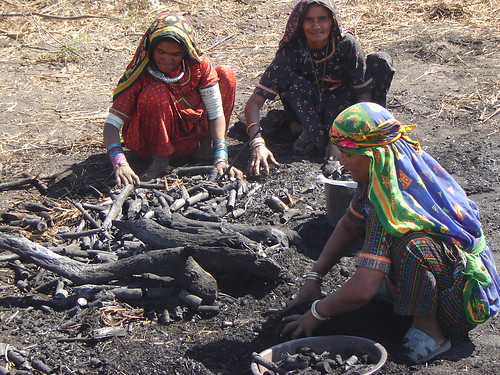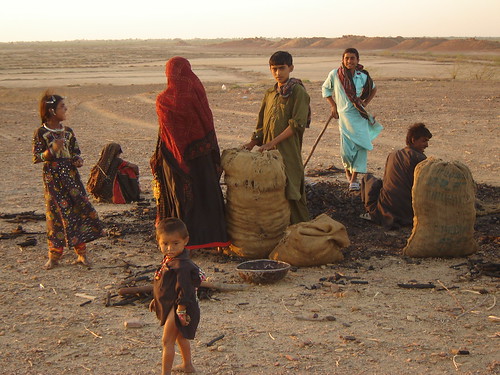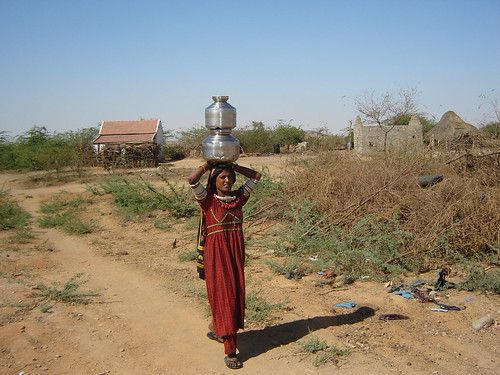By Yoginder Sikand
The Great Rann of Kutch, stretching over much of the northern part of Gujarat’s remote Kutch district and spilling over across the border in Pakistan’s Sindh province, is a fragile desert ecological zone. It consists of flat sandy and stony plains that stretch as far as the horizon, interspersed with small rocky hillocks, dotted, in some parts, with thorny, ankle-length bushes. Large parts of the area do not boast of any vegetation at all, being covered with massive sheets of salt.
This region witnesses regular drought, and for much of the year, owing to the intense heat, the land is cracked and deeply fissured like a shattered mirror. Although it rains little here, sometimes during the monsoons large parts of the area becomes a massive swamp, making communications impossible.
Harsh and inhospitable though the land is, there are numerous small villages and settlements on the fringes of the Rann. Most of the people who live here are Sindhi- and Kutchi-speaking Muslims, who belong to over three dozen caste-like groups. Traditionally, most of them were maldharis or cattle-grazers, maintaining flocks of goats, camels and buffaloes and earning their living by selling their milk. In addition to the Muslims, there are a sizeable number of Dalits and other so-called ‘low’ castes living here. The vast majority of the denizens of this region, Muslims and Dalits, live below the officially recognized poverty line. The government has done little, if at all, for their economic development. Most of them continue to live a virtually hand-to-mouth existence. Their pathetic poverty seems, in fact, to have further worsened in recent years as their traditional pasture lands have been rapidly depleting due to over-grazing, persistent drought-like conditions and expanding urbanisation.
 And that is what is forcing large numbers of families living around the Rann to literally ‘charcoal the desert’. Around two decades ago, in a bid to check the advance of the encroaching desert, government authorities arranged for a thorny desert bush, commonly known in India as the Babul and in Kutch as the Jangli or Ganda Bavar (‘Wild’ or ‘Bad’ Babul, the Acacia nilotica) to be imported from Israel and to be planted in semi-desert parts of northern Kutch. Once planted, the bush, which, if allowed to grow, reaches a height of around ten feet, spreads like wild-fire on its own across vast stretches of land, each bush producing, in turn, dozens more without having to be tended to.
And that is what is forcing large numbers of families living around the Rann to literally ‘charcoal the desert’. Around two decades ago, in a bid to check the advance of the encroaching desert, government authorities arranged for a thorny desert bush, commonly known in India as the Babul and in Kutch as the Jangli or Ganda Bavar (‘Wild’ or ‘Bad’ Babul, the Acacia nilotica) to be imported from Israel and to be planted in semi-desert parts of northern Kutch. Once planted, the bush, which, if allowed to grow, reaches a height of around ten feet, spreads like wild-fire on its own across vast stretches of land, each bush producing, in turn, dozens more without having to be tended to.
It appears that no serious survey was done to gauge all the possible effects of introducing the Ganda Bavar in northern Kutch. Today, the devastating effects of the plant are obvious, as local inhabitants readily relate. At the same time, however, the plant has now become, for many of these families, their only source of income, or, at least, the most lucrative one.
Till three years ago, cutting the Ganda Bavar was banned in Kutch. Now, almost every family in many settlements in northern Kutch supplements its meagre income by felling the tree and burning its wood in large pyramid-shaped piles to make charcoal, or kolsa as it is locally called. This involves tiring labour—going deep into the interior of the wastelands on foot in the scorching heat to cut down the branches of the tree, taking care not to get poked by its menacing thorns, transporting the branches back to the village, breaking the branches into small pieces and tending to the smoking fires slowly that burn the wood over a few days till they are completely charred. Then, the wood, now turned into charcoal, is beaten into smaller pieces, stuffed into gunny sacks and then loaded on camel-carts or trucks.
 Making charcoal involves the entire family, even children, which explain, in part, why almost no children above the age of ten attend schools in those few villages in the area that are fortunate to have one. An average family can make around ten sacks of charcoal a month, each weighing forty kilogrammes. Middlemen, from towns in Kutch and elsewhere in Gujarat, travel these remote villages in trucks, buying the charcoal for a pittance. ‘Earlier’, explains Wali Sahib, of Wazira village, ‘we used to get around three hundred rupees per sack, but the middlemen have now formed an association, and they have reduced the price to two hundred rupees only’. ‘At the same time’, he adds, ‘now that we have this new source of livelihood, we no longer need to migrate out of our villages in search of labour work elsewhere. But still, during the rainy months and also at the height of summer, when it is scorching hot in the desert, charcoal-making work stops, and then again we face the constant problem of hunger.’
Making charcoal involves the entire family, even children, which explain, in part, why almost no children above the age of ten attend schools in those few villages in the area that are fortunate to have one. An average family can make around ten sacks of charcoal a month, each weighing forty kilogrammes. Middlemen, from towns in Kutch and elsewhere in Gujarat, travel these remote villages in trucks, buying the charcoal for a pittance. ‘Earlier’, explains Wali Sahib, of Wazira village, ‘we used to get around three hundred rupees per sack, but the middlemen have now formed an association, and they have reduced the price to two hundred rupees only’. ‘At the same time’, he adds, ‘now that we have this new source of livelihood, we no longer need to migrate out of our villages in search of labour work elsewhere. But still, during the rainy months and also at the height of summer, when it is scorching hot in the desert, charcoal-making work stops, and then again we face the constant problem of hunger.’
Since, for many families in this remote, poverty-stricken corner of Kutch the Ganda Bavar has now become the main, or even only, form of income, there has been an indiscriminate cutting down of the tree. ‘The thicker the branches and stem of the tree, the better the quality of charcoal that it makes’, explains Naseema, a middle-aged woman from Luna village, who spends almost ten hours a day making charcoal. ‘Since the thicker trees in or near the villages have all been cut down and made into charcoal, we are increasingly forced to go deep into the jungle to search for thicker Ganda Bavar, but because so many people now rely on this for their livelihood, it is becoming increasingly difficult to find thick Ganda Bavar for cutting’.
‘We are all poor people’, adds her husband Roshan. ‘We cannot afford to hire a vehicle to go into the jungle to gather wood. So, we all, men, women and children, are forced to walk several kilometres every day into the jungle and all the way back to our village, carrying the heavy load of wood on our backs.’
The thick smoke spewing out of the charcoal fires is the cause of new respiratory diseases and eye aliments in the area. There are almost no government-run health centres here, and, villagers say, paramedical officers rarely, if ever, visit their remote hamlets. The Ganda Bavar is also a potent threat to their goats and cows, causing their teeth to rot and knots to be formed in their stomachs, although it does not have the same effect on buffaloes and camels.

Kutchi woman with ganda bavar in background
The indiscriminate growth of the Ganda Bavar threatens local varieties of trees and plants too. Says Hasan Jath of Hala Vandh, ‘The Ganda Bavar grows rapidly, and as a result, the native Meetha or sweet Bavar that grew here earlier, which provided us gum and wood for making furniture, has been almost totally exterminated. The Ganda Bavar sheds a huge number of leaves in the monsoons, making it impossible for local grasses, which we use for fodder and other purposes, to grow.’
His wife Sohana adds, ‘Earlier we had so many different types of grasses here, such as Dinoi, Draman, Khevai, Unn and Lambh, but now these have rapidly reduced, in part because of the Ganda Bavar. The Ganda Bavar consumes a lot of water, unlike the native Babul. Because of this, the water-table in the area, already very low, has gone down further.’ ‘And’, she complains, ‘the thorns of the Ganda Bavar pierce the udders of our animals and badly injure them.’
The Ganda Bavar thus might be proving to be a silent disaster, which is probably why, three years ago, the government lifted its ban on cutting the tree. But now since vast numbers of families in this impoverished part of Kutch have become so dependent on the tree simply to survive, its wholesale destruction raises crucial questions related to people’s livelihood, in the absence of any measures by the state to provide the locals alternate sources of livelihood. Further, as Salim Samma, a cattle-grazer in Haji Pir, a settlement not far from the Pakistan border, says, ‘Completely exterminating the plant might have its own share of serious ecological consequences. Yes, the plant does take up a lot of water, a precious commodity in the desert. But now that it has spread all over, cutting down all the trees might lead to excessive flooding and water-logging.’
‘The authorities’, he suggests, ‘should do a proper survey and introduce new plants to take its place that, while being ecologically friendly, also provide a source of income for our desperately poor people’.
But will that really happen?
[Photos by Yoginder Sikand]

